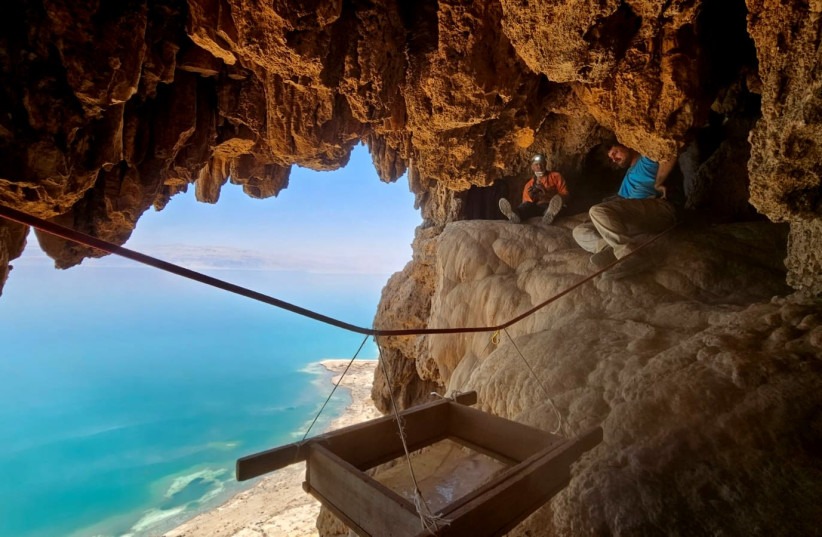Four ancient but well-preserved swords -- found serendipitously by an Ariel University archaeologist who slipped his hand into a hole in a hidden chamber of a Judean Desert Cave -- have been named the “Number-One Find for 2023” of National Geographic Magazine.
The cache of Roman weaponry, protected from the elements for some 1,900 years by the dry heat, included four long and straight (spatha) swords and a javelin head.
Found in the cave at Israel’s Ein Gedi Nature Reserve, they were presented to journalists under a heavily protected glass case on September 6 by Israel Antiquities Authority (IAA) scholars. “To find one sword like this is rare, so four? It’s a dream come true,” the researchers noted. “We couldn’t believe our eyes.”
The weapons cache was most likely hidden by Jewish rebels some 1,900 years ago, the authority said, after being seized from Roman forces. One of the IAA staff said it was possible that in their continuing examinations of the weapons, they might detect DNA on them that would provide even more incredible details.
'It's a dream' find
An expedition into the cave led by Ariel University’s Asaf Gayer and geologist Boaz Langford, initially planned to take multispectral footage of ink-written Hebrew inscriptions found on a stalactite, stumbled upon the hidden chamber where they also found pieces of process wood and leather straps, later discovered to be used as part of the swords’ scabbards.
Dr. Eitan Klein, one of the directors of the Judean Desert Survey Project, said, “Obviously, the rebels didn’t want to be caught by the Roman authorities carrying these weapons. We are just beginning the research on the cave and the weapon cache discovered in it, aiming to try to find out who owned the swords and where, when, and by whom they were manufactured. We will try to pinpoint the historical event that led to the caching of these weapons in the cave and determine whether it was at the time of the Bar Kochba Revolt in 132-135 CE.”
Three of the swords were found with the blades still concealed, preserving the steel, with crafted iron and wood-made handles. The researchers identified the three swords to be spatha due to the length of their blades, measuring 60 to 65 cm.
The fourth sword was identified as a ring pommel sword due to its 45 cm. blade. The team said the swords were so sharp, they could cut a slice of meat today.
“It is an extraordinary privilege to take part in such a discovery and the excitement is immeasurable,” Gayer then said. “The inscription and the weapons teach us a new chapter about the way Jews used the caves of the Judean desert in the different periods.”
Use for the caves
The caves are under the jurisdiction of the National Parks Authority. The IAA, headed by Eli Escuzito, has been carrying out six years of archaeological surveys and excavations in the Judean Desert caves together with the Ministry of Heritage, Ariel University, the Center for Cave Research at the Hebrew University of Jerusalem, and the Archaeological Office for the Military Administration of Judea and Samaria.
National Geographic gave second place to a giant stonehead from Easter Island in the Pacific Ocean. The sword collection also won seventh place in the Top Ten of Heritage Daily’s 2023 list.
“The disposal of the swords in deep crevices in an isolated cave north of Ein Gedi suggested that the weapons were taken as booty from Roman soldiers or from the battlefield and were deliberately hidden by Jewish rebels for reuse,” suggested Klein.
“It is likely that the rebels did not want to be caught with their weapons on them in an encounter with the Roman authorities.”

At the foot of the cave’s entrance, a bronze coin from the days of the Bar-Kochva rebellion was found, perhaps a hint of the time period when the cave was used as a clearing.
“I am proud of the team of researchers for the worldwide recognition of the discovery," said Escuzido. “We are in the Hanukkah holiday, and a little light dispels a lot of darkness.
The cache of weapons attributed to the rebels of the Bar Kochba rebellion was published in the media in Israel and around the world, exactly one month before the Iron Swords War. It is not impossible that it also inspired the choice of the name of the war.
"This is a chilling and exciting discovery, touching a moment in time and writing us new and fascinating pages in the history books.”
